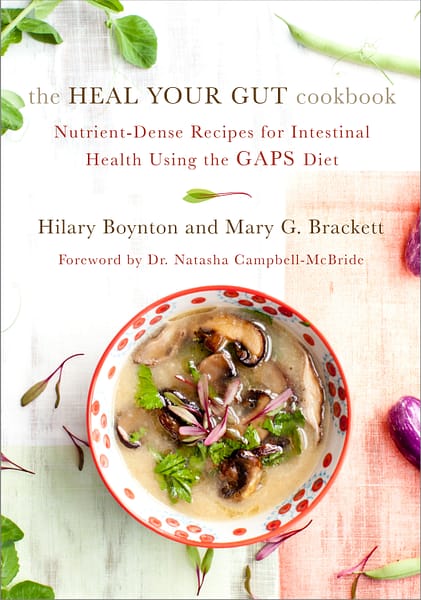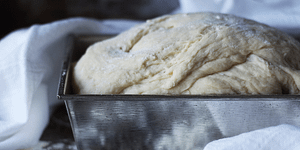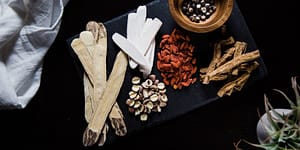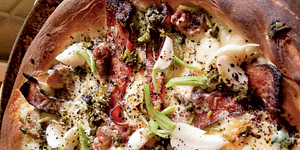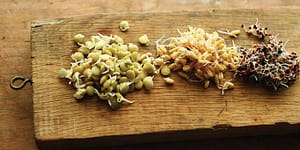Medlar Cream Cake: so simple yet so good

If you’re looking for a simple cake to serve guests, try this medlar cream cake.
What’s a medlar? The fruit of the medlar tree, Mespilus germanica, tastes like lightly spiced apple butter scooped soft right out of the russeted skin.
The Occidental Arts and Ecology Center in California has a small but significant collection of these rare trees, which have been cultivated for over 3,000 years in Central and Northern Europe. They are one of the few fruits that ripen in cold winter conditions—a welcome Medlar treat for seasonal eaters during an otherwise fruit-scarce time.
Medlars, like Haichya persimmons, serviceberries, and some pears, must be bletted, meaning they must be chilled and overripened to render their otherwise astringent fruit soft and palatable. The first frost triggers or accelerates the bletting process by breaking down cell walls to release sugars and begin a mild fermentation. In modern times, pears and other fruits requiring bletting often have it done artificially for better control through refrigeration.
This excerpt is from The Occidental Arts and Ecology Center Cookbook by The Occidental Arts and Ecology Center with Olivia Rathbone. It has been adapted for the web.
This cake is so simple and yet so good— crunchy crust forms while the medlar pastry cream filling bakes into the center of the cake. Don’t worry if you have never seen or heard of a medlar! They are extremely rare and never sold at markets, but you might just have a neighbor that grows this long-forgotten fruit. You can make this cake without the medlar and still will have your guests oohing and aahing. For a gathering of 30 to 40, make two 12-inch cakes.
Serves 16
Makes one 12-inch round cake
Medlar Pastry Cream
13⁄4 cups whole milk
1⁄3 cup sugar, divided
3 large egg yolks
2 tablespoons plus 2 teaspoons cornstarch
2 tablespoons butter
3⁄4 cup medlar fruit, de-seeded through a sieve, or substitute dark apple or pear butter
Cake
2 cups (4 sticks) unsalted butter, softened at room temperature
2 cups sugar
4 large eggs, room temperature
2 teaspoons vanilla extract
21⁄4 cups all-purpose flour
2 teaspoons baking powder
1 teaspoon salt
1 cup medlar pastry cream or regular pastry cream
To prepare the medlar: Gather about a quart of bletted fruit. Medlar fruit is ripe when completely soft and squishy. We let the medlar blet or ripen on the tree, but you can harvest while firm and ripen in a cool room or fridge. The consistency is like pudding with a cluster of seeds. To get just the flesh with no seeds, push all the interior contents through a medium-sized sieve until you have 3⁄4 cup.
Place the milk in a heavy-bottomed saucepan with half of the sugar. Heat on medium just until it starts steaming. While the milk is heating, whisk the egg yolks in a metal bowl with the other half of the sugar and the cornstarch. When the milk is hot, remove from the heat and whisk a little at a time into the yolk mixture, until you have added all the milk. Pour back into the saucepan. Turn the heat back to low and stir constantly with a spatula. Watch for the pastry cream to thicken to the point that your stirring spatula will leave an opening to the bottom of the pot and the mixture is thick like a pudding—this will happen fast! Remove from the heat immediately. Stir in the butter until smooth. If you are using the medlar fruit, then add this now by folding into the pastry cream. Set aside in the refrigerator. This can be made up to 2 days in advance, stored in the fridge.
To make the cake: Preheat the oven to 350°F. Before beginning, it is very important to be sure that all your ingredients are soft and warm. Ideally, even the temperature in your kitchen should be warm to ensure a soft batter! Prepare a 12-inch cake pan with a parchment circle for the bottom and a thin layer of butter for the sides.

Spoon the cakebatter into a large tipless pastry bag. Pipe half of the batter in a tight spiral into the bottom of the pan. Pipe an extra ring around the inside edge of the pan, building up the sides slightly to create a well in the center that will prevent the filling from seeping out to the edge. Spread the medlar pastry cream evenly in this well using a small spatula or knife. Pipe the remaining cake batter in a spiral on top, sandwiching the pastry cream in the center. Use your spatula to move the cake batter over the top, covering the filling as much as possible. It’s okay if a bit of the filling shows through; when it heats in the oven it will spread out more.
Bake for 1 to 11⁄2 hours. Check the cake at 1 hour; if it needs more time, let it continue baking for up to another half hour. It should spring back lightly in the center when it is done. Remove from the oven and let cool for 15 minutes before unmolding. Dust the top with powdered sugar, then slice and enjoy.
Recent Articles
Want to spice up your traditional bread recipes? This salt-rising bread recipe by fermentation expert Sandor Ellix Katz has all the simplicity, flavor, and uniqueness you’ve been searching for! The following is an excerpt from Sandor Katz’s Fermentation Journeys by Sandor Ellix Katz. It has been adapted for the web. What Is Salt-Rising Bread? Salt-rising…
Read MoreLearning how to ask questions that will elicit relevant information is as much an art form as creating an herbal formula. Follow this broad list as a starting point.
Read MoreNothing says “spring” like a fresh, foraged meal! Savor the flavors of the season with this Milkweed Bud Pizza recipe.
Read MoreOxeye daisies are one of the most important plants for pollinators including beetles, ants, and moths that use oxeye daisies as a source of pollen and nectar. Instead of thinking about removing a plant like oxeye daisy, consider how you can improve the fertility and diversity of habitat resources in your home landscape, garden, or…
Read More
